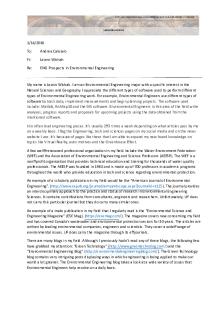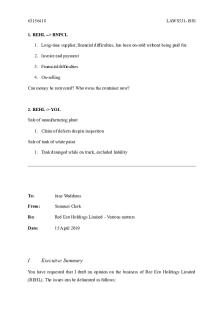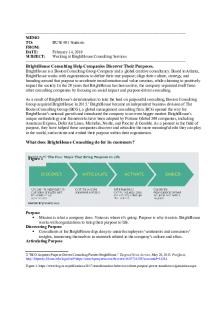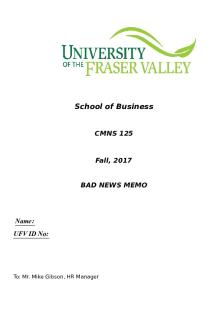COS3721 Theory memo PDF

| Title | COS3721 Theory memo |
|---|---|
| Course | Operating Systems And Architecture |
| Institution | University of South Africa |
| Pages | 51 |
| File Size | 949.4 KB |
| File Type | |
| Total Downloads | 219 |
| Total Views | 281 |
Summary
Download COS3721 Theory memo PDF
Description
Operating System #IT241 Chapter 1 Multiple Choice 1. In what way is an operating system like a government? A) It seldom functions correctly. B) It creates an environment within which other programs can do useful work. C) It performs most useful functions by itself. D) It is always concerned primarily with the individual's needs. Ans: B 2. ____ operating systems are designed primarily to maximize resource utilization. A) PC B) Handheld computer C) Mainframe D) Network Ans: C 3. The most common secondary storage device is ____. A) random access memory B) solid state disks C) tape drives D) magnetic disk Ans: D 4. Which of the following would lead you to believe that a given system is an SMP-type system? A) Each processor is assigned a specific task. B) There is a boss–worker relationship between the processors. C) Each processor performs all tasks within the operating system. D) None of the above Ans: C 5. A ____ can be used to prevent a user program from never returning control to the operating system. A) portal B) program counter C) firewall D) timer Ans: D 6. Embedded computers typically run on a ____ operating system. A) real-time B) Windows XP C) network D) clustered Ans: A 7. Bluetooth and 802.11 devices use wireless technology to communicate over several feet, in essence creating a ____. A) local-area network B) wide-area network C) small-area network D) metropolitan-area network Ans: C 8. A clustered system ____. A) gathers together multiple CPUs to accomplish computational work B) is an operating system that provides file sharing across a network C) is used when rigid time requirements are present D) can only operate one application at a time Ans: A 9. Which of the following is a property of peer-to-peer systems? A) Clients and servers are not distinguished from one another. B) Separate machines act as either the client of the server but not both. C) They do not offer any advantages over traditional client-server systems. D) They suffer from the server acting as the bottleneck in performance. Ans: A 10. Two important design issues for cache memory are ____. A) speed and volatility B) size and replacement policy C) power consumption and reusability D) size and access privileges Ans: B Maha Otaibi
!
11. What are some other terms for kernel mode? A) supervisor mode B) system mode C) privileged mode D) All of the above Ans: D 12. Which of the following statements concerning open source operating systems is true? A) Solaris is open source. B) Source code is freely available. C) They are always more secure than commercial, closed systems. D) All open source operating systems share the same set of goals. Ans: B 13. Which of the following operating systems is not open source? A) Windows B) BSD UNIX C) Linux D) PCLinuxOS Ans: A 14. A _____ provides a file-system interface which allows clients to create and modify files. A) compute-server system B) file-server system C) wireless network D) network computer Ans: B 15. A ____ is a custom build of the Linux operating system A) LiveCD B) installation C) distribution D) VMWare Player Ans: C 16. __________ is a set of software frameworks that provide additional services to application developers. A) System programs B) Virtualization C) Cloud computing D) Middleware Ans: D 17. What statement concerning privileged instructions is considered false? A) They may cause harm to the system. B) They can only be executed in kernel mode. C) They cannot be attempted from user mode. D) They are used to manage interrupts. Ans: C 18. Which of the following statements is false? A) Mobile devices must be concerned with power consumption. B) Mobile devices can provide features that are unavailable on desktop or laptop computers. C) The difference in storage capacity between a mobile device and laptop is shrinking. D) Mobile devices usually have fewer processing cores than a standard desktop computer. Ans: C 19. A(n) ________ is the unit of work in a system. A) process B) operating system C) timer D) mode bit Ans: A 20. The two separate modes of operating in a system are A) supervisor mode and system mode B) kernel mode and privileged mode C) physical mode and logical mode D) user mode and kernel mode Ans: D
Maha Otaibi
!
Essay 21. Explain why an operating system can be viewed as a resource allocator. Ans: A computer system has many resources that may be required to solve a problem: CPU time, memory space, file-storage space, I/O devices, and so on. The operating system acts as the manager of these resources. Facing numerous and possibly conflicting requests for resources, the operating system must decide how to allocate them to specific programs and users so that it can operate the computer system efficiently and fairly. 22. Explain the purpose of an interrupt vector. Ans: The interrupt vector is merely a table of pointers to specific interrupt-handling routines. Because there are a fixed number of interrupts, this table allows for more efficient handling of the interrupts than with a general-purpose, interrupt-processing routine. 23. What is a bootstrap program, and where is it stored? Ans: A bootstrap program is the initial program that the computer runs when it is powered up or rebooted. It initializes all aspects of the system, from CPU registers to device controllers to memory contents. Typically, it is stored in read-only memory (ROM) or electrically erasable programmable read-only memory (EEPROM), known by the general term firmware, within the computer hardware. 24. What role do device controllers and device drivers play in a computer system? Ans: A general-purpose computer system consists of CPUs and multiple device controllers that are connected through a common bus. Each device controller is in charge of a specific type of device. The device controller is responsible for moving the data between the peripheral devices that it controls and its local buffer storage. Typically, operating systems have a device driver for each device controller. This device driver understands the device controller and presents a uniform interface for the device to the rest of the operating system. 25. Why are clustered systems considered to provide high-availability service? Ans: Clustered systems are considered high-availability in that these types of systems have redundancies capable of taking over a specific process or task in the case of a failure. The redundancies are inherent due to the fact that clustered systems are composed of two or more individual systems coupled together. 26. Describe the differences between physical, virtual, and logical memory. Ans: Physical memory is the memory available for machines to execute operations (i.e., cache, random access memory, etc.). Virtual memory is a method through which programs can be executed that requires space larger than that available in physical memory by using disk memory as a backing store for main memory. Logical memory is an abstraction of the computer’s different types of memory that allows programmers and applications a simplified view of memory and frees them from concern over memory-storage limitations. 27. Describe the operating system's two modes of operation. Ans: In order to ensure the proper execution of the operating system, most computer systems provide hardware support to distinguish between user mode and kernel mode. A mode bit is added to the hardware of the computer to indicate the current mode: kernel (0) or user (1). When the computer system is executing on behalf of a user application, the system is in user mode. However, when a user application requests a service from the operating system (via a system call), it must transition from user to kernel mode to fulfill the request. 28. Explain cache coherency. Ans: In multiprocessor environments, two copies of the same data may reside in the local cache of each CPU. Whenever one CPU alters the data, the cache of the other CPU must receive an updated version of this data. Cache coherency involves ensuring that multiple caches store the most updated version of the stored data. 29. Why is main memory not suitable for permanent program storage or backup purposes? Furthermore, what is the main disadvantage to storing information on a magnetic disk drive as opposed to main memory? Ans: Main memory is a volatile memory in that any power loss to the system will result in erasure of the data stored within that memory. While disk drives can store more information permanently than main memory, disk drives are significantly slower. 30. Describe the compute-server and file-server types of server systems. Ans: The compute-server system provides an interface to which a client can send a request to perform an action (for example, read data from a database); in response, the server executes the action and sends back results to the client. The file-server system provides a file-system interface where clients can create, update, read, and delete files. An example of such a system is a Web server that delivers files to clients running Web browsers. 31. Computer systems can be divided into four approximate components. What are they? Ans: Hardware, operating system, application programs, and users. 32. Distinguish between system and application programs. Ans: System programs are not part of the kernel, but still are associated with the operating system. Application programs are not associated with the operating of the system. 33. Describe why direct memory access (DMA) is considered an efficient mechanism for performing I/O. Ans: DMA is efficient for moving large amounts of data between I/O devices and main memory. It is considered efficient because it removes the CPU from being responsible for transferring data. DMA instructs the device controller to move data between the devices and main memory. Maha Otaibi
!
34. Describe why multi-core processing is more efficient than placing each processor on its own chip. Ans: A large reason why it is more efficient is that communication between processors on the same chip is faster than processors on separate chips. 35. Distinguish between uniform memory access (UMA) and non-uniform memory access (NUMA) systems. Ans: On UMA systems, accessing RAM takes the same amount of time from any CPU. On NUMA systems, accessing some parts of memory may take longer than accessing other parts of memory, thus creating a performance penalty for certain memory accesses. 36. Explain the difference between singly, doubly, and circularly linked lists. Ans: A singly linked list is where each item points to its successor. A doubly linked linked list allows an item to point to its predecessor or successor. A circularly linked list is the where the last element points back to the first. 37. What two operating systems currently dominate mobile computing? Ans: Apple's iOS and Google's Android 38. Explain the difference between protection and security. Ans: Protection is concerned with controlling the access of processes or users to the resources of the computer system. The role of security is to defend the system from internal or external attacks. 39. Distinguish mobile computing from traditional desktop computing. Ans: Mobile computing takes place on handheld devices and tablets. Because these devices are portable and lightweight, they typically do not have the processing power and storage capacity of desktop systems. However, features such as GPS and accelerometers have allowed mobile devices to provide functionality that is unavailable to desktop systems. 40. Describe cloud computing. Ans: Cloud computing is a type of computing that delivers computing,storage, and application services across a network. Cloud computing often uses virtualization to provide its functionality. There are many different types of cloud environments, as well as services offered. Cloud computing may be either public, private, or a hybrid of the two. Additionally, cloud computing may offer applications, platforms, or system infrastructures.
True/False 41. The operating system kernel consists of all system and application programs in a computer. False 42. Flash memory is slower than DRAM but needs no power to retain its contents. True 43. A system call is triggered by hardware. False 44. UNIX does not allow users to escalate privileges to gain extra permissions for a restricted activity. False 45. Processors for most mobile devices run at a slower speed than a processor in a desktop PC. True 46. Interrupts may be triggered by either hardware of software. True 47. A dual-core system requires each core has its own cache memory. False 48. Virtually all modern operating systems provide support for SMP. True 49. All computer systems have some sort of user interaction. False 50. Solid state disks are generally faster than magnetic disks. True 51. Solid state disks are considered volatile storage. False 52. There is no universally accepted definition of an operating system. True
Chapter 2 Multiple Choice 1. A _____ is an example of a systems program. A) command interpreter B) Web browser C) text formatter D) database system Ans: A Maha Otaibi
!٤
2. If a program terminates abnormally, a dump of memory may be examined by a ____ to determine the cause of the problem. A) module B) debugger C) shell D) control card Ans: B 3. A message-passing model is ____. A) easier to implement than a shared memory model for intercomputer communication B) faster than the shared memory model C) a network protocol, and does not apply to operating systems D) only useful for small simple operating systems Ans: A 4. Policy ____. A) determines how to do something B) determines what will be done C) is not likely to change across places D) is not likely to change over time Ans: B 5. The major difficulty in designing a layered operating system approach is ____. A) appropriately defining the various layers B) making sure that each layer hides certain data structures, hardware, and operations from higher-level layers C) debugging a particular layer D) making sure each layer is easily converted to modules Ans: A 6. A microkernel is a kernel ____. A) containing many components that are optimized to reduce resident memory size B) that is compressed before loading in order to reduce its resident memory size C) that is compiled to produce the smallest size possible when stored to disk D) that is stripped of all nonessential components Ans: D 7. To the SYSGEN program of an operating system, the least useful piece of information is _____. A) the CPU being used B) amount of memory available C) what applications to install D) operating-system options such as buffer sizes or CPU scheduling algorithms Ans: C 8. A boot block ____. A) typically only knows the location and length of the rest of the bootstrap program B) typically is sophisticated enough to load the operating system and begin its execution C) is composed of multiple disk blocks D) is composed of multiple disk cylinders Ans: A 9. _____ provide(s) an interface to the services provided by an operating system. A) Shared memory B) System calls C) Simulators D) Communication Ans: B 10. _____ is not one of the major categories of system calls. A) Process control B) Communications C) Protection D) Security Ans: D 11. _____ allow operating system services to be loaded dynamically. A) Virtual machines B) Modules C) File systems D) Graphical user interfaces Ans: B
Maha Otaibi
!٥
12. Microkernels use _____ for communication. A) message passing B) shared memory C) system calls D) virtualization Ans: A 13. The Windows CreateProcess() system call creates a new process. What is the equivalent system call in UNIX: A) NTCreateProcess() B) process() C) fork() D) getpid() Ans: C 14. The close() system call in UNIX is used to close a file. What is the equivalent system call in Windows: A) CloseHandle() B) close() C) CloseFile() D) Exit() Ans: A 15. The Windows CreateFile() system call is used to create a file. What is the equivalent system call in UNIX: A) ioctl() B) open() C) fork() D) createfile() Ans: B 16. Android runs Java programs _____________ A) in the Dalvik virtual machine. B) natively. C) in the Java virtual machine. D) Android does not run Java programs. Ans: A 17. ______ is a mobile operating system designed for the iPhone and iPad. A) Mac OS X B) Android C) UNIX D) iOS Ans: D 18. The ________ provides a portion of the system call interface for UNIX and Linux. A) POSIX B) Java C) Standard C library D) Standard API Ans: C 19. Which of the following statements is incorrect? A) An operating system provides an environment for the execution of programs. B) An operating system manages system resources. C) Operating systems provide both command line as well as graphical user interfaces. D) Operating systems must provide both protection and security. Ans: C 20. _____ is/are not a technique for passing parameters from an application to a system call. A) Cache memory B) Registers C) Stack D) Special block in memory Ans: A
Essay 21. There are two different ways that commands can be processed by a command interpreter. One way is to allow the command interpreter to contain the code needed to execute the command. The other way is to implement the commands through system programs. Compare and contrast the two approaches. Ans: In the first approach, upon the user issuing a command, the interpreter jumps to the appropriate section of code, executes the command, and returns control back to the user. In the second approach, the interpreter loads the appropriate program into memory along with the appropriate arguments. The advantage of the first method is speed and overall simplicity. The disadvantage to this Maha Otaibi
!٦
technique is that new commands require rewriting the interpreter program which, after a number of modifications, may get complicated, messy, or too large. The advantage to the second method is that new commands can be added without altering the command interpreter. The disadvantage is reduced speed and the clumsiness of passing parameters from the interpreter to the system program. 22. Describe the relationship between an API, the system-call interface, and the operating system. Ans: The system-call interface of a programming language serves as a link to system calls made available by the operating system. This interface intercepts function calls in the API and invokes the necessary system call within the operating system. Thus, most of the details of the operating-system interface are hidden from the programmer by the API and are managed by the run-time support library. Feedback: 2.3 Difficulty: Hard 23. Describe three general methods used to pass parameters to the operating system during system calls. Ans: The simplest approach is to pass the parameters in registers. In some cases, there may be more parameters than registers. In these cases, the parameters are generally stored in a block, or table, of memory, and the address of the block is passed as a parameter in a register. Parameters can also be placed, or pushed, onto the stack by the program and popped off the stack by the operating system. 24. What are the advantages of using a higher-level language to implement an operating system? Ans: The code can be written faster, is more compact, and is easier to understand and debug. In addition, improvements in compiler technology will improve the generated code for the entire operating system by simple recompilation. Finally, an operating system is far easier to port — to move to some other hardware — if it is written in a higher-level language. 25. Describe some requirements, or goals, when designing an operating system. Ans: Requirements can be divided into user and system goals. Users desire a system that is convenient to use, easy to learn, and to use, reliable, safe, and fast. System goals are defined by those people who must design, create, maintain, and operate the system: The system should be easy to design, implement, and maintain; it should be flexible, reliable, error-free, and efficient. 26. What are the advantages and disadvantages of using a microkernel approach? Ans: One benefit of the microkernel approach is ease of extending the operating system. All new services are added to user space and consequently do not require modificatio...
Similar Free PDFs

COS3721 Theory memo
- 51 Pages

COS3721 Practise notes
- 16 Pages

Memo - Memo
- 2 Pages

Memo - Business Memo Assignment
- 2 Pages

Memo - Memo for stocks
- 2 Pages

Memo 1 - Memo 1 Assignment
- 2 Pages

Laptop Memo - BIT-200 Memo
- 2 Pages

TWC Assignment Memo 2 and Memo 4
- 4 Pages

Final memo
- 2 Pages

Intake Memo
- 3 Pages

Memo assignment
- 10 Pages

WTW114 Exam 2017 Memo - Exam Memo
- 13 Pages

Memo Instructions
- 1 Pages

Bright House Consulting Memo
- 3 Pages
Popular Institutions
- Tinajero National High School - Annex
- Politeknik Caltex Riau
- Yokohama City University
- SGT University
- University of Al-Qadisiyah
- Divine Word College of Vigan
- Techniek College Rotterdam
- Universidade de Santiago
- Universiti Teknologi MARA Cawangan Johor Kampus Pasir Gudang
- Poltekkes Kemenkes Yogyakarta
- Baguio City National High School
- Colegio san marcos
- preparatoria uno
- Centro de Bachillerato Tecnológico Industrial y de Servicios No. 107
- Dalian Maritime University
- Quang Trung Secondary School
- Colegio Tecnológico en Informática
- Corporación Regional de Educación Superior
- Grupo CEDVA
- Dar Al Uloom University
- Centro de Estudios Preuniversitarios de la Universidad Nacional de Ingeniería
- 上智大学
- Aakash International School, Nuna Majara
- San Felipe Neri Catholic School
- Kang Chiao International School - New Taipei City
- Misamis Occidental National High School
- Institución Educativa Escuela Normal Juan Ladrilleros
- Kolehiyo ng Pantukan
- Batanes State College
- Instituto Continental
- Sekolah Menengah Kejuruan Kesehatan Kaltara (Tarakan)
- Colegio de La Inmaculada Concepcion - Cebu

